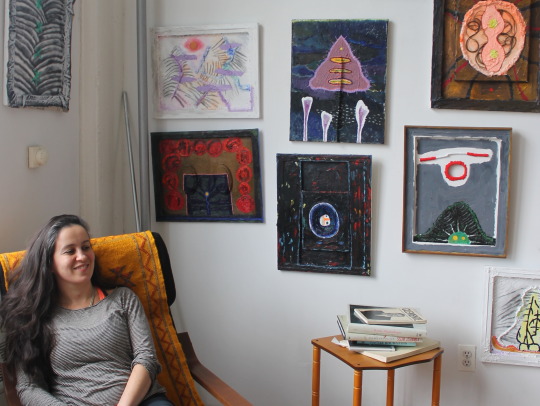IAP Interview: Yevgeniya Baras
“I really see curation as another way of making work.”
Yevgeniya Baras is a contemporary painter and co-founder of the Regina Rex Gallery on the Lower East Side. NYFA visited her studio at the Sharpe-Walentas Studio Program to find out how she balances her business with her artistic practice, how artists get noticed, and how her immigrant experience influences her work. Yevgeniya is represented by Nicelle Beauchene Gallery and has an upcoming solo show in September 2016.
NYFA: Did your immigrant experience influence your artistic experience in any way?
Yevgeniya Baras: Immigration is one of the most significant processes I have lived through. This experience is one of the lenses through which I view the everyday. Though immigration is such a complex difficult course, I neither view myself as its victim nor am I interested in nostalgia. I’m concerned with mobilizing what I’ve experienced, taking that energy and creating with it, educating with it, and having empathy for others with it. Since you’re sitting in my studio, you can see my work is speaking a rather abstract language of personal symbology. This language deals with my identity and a crucial aspect of my identity is immigration. Immigration is a chance for transformation and a redefinition of values. (Becoming an artist is another immigration.) Immigration happened to me. Circumstances, my lineage, historical events, my parents were making choices on my behalf. But what I think is important is how this becomes a new chance at life.
I feel really blessed that I lived through my experience as an immigrant. Moving was challenging because I came with no English language as a teenager to a place that could not be any more different than the former Soviet Union. It is an intricate process your inner world goes through for so many reasons. Immigration makes you simultaneously more vulnerable and tremendously toughens your skin.
NYFA: How do you and the collective decide who to feature in Regina Rex?
YB: My eyes are out in the world and so are the eyes of all the members of Regina Rex. When we meet once a week, we share ideas. If I bring up an artist or a concept, someone else in the group may say: “Wouldn’t it be interesting if this person’s work was shown in relation to this person’s work or what about considering your idea from another angle.” So it’s a very organic, discussion-based process. We workshop exhibition ideas together until they are ripe. All of us are artists, it’s an artist run space, and we never show our own work. I am regularly in studios of artists whose work is completely unlike my own which sharpens my ability to think and speak about the work of others. Curation forces me outside of my tastes. I actively consider, think about, learn, and expand my palette. And of course sometimes shows I curate look like a direct extension of what I’m thinking about here in my studio. I really see curation as another way of making work.
NYFA: What makes an artist stand out?
YB: A studio visit is always half a day, even if its actual duration is an hour. If you’re doing a studio visit, it’s about analysis and the ability to feel. You’re doing psychological and emotional work, so when you walk out you’re drained. I regularly exchange studio visits with friends with whom I have a continuous dialogue and whose eyes, minds, and hearts I trust. But with visiting artists I am not familiar with- I do so selectively based on a suggestion of a friend or something I found in a group show that I want to explore further . Nothing is sexier than somebody working really hard, like if I arrive at a studio full of art, full of ideas. Even if it’s not so interesting to me, if I see a real devotion, I will pay attention to it with a different spirit than if I visit a studio and there is laziness. What stands out is an artist’s very intimate relationship to their own practice, that they are really present in this strange world they have created. That I feel the maker asking personal difficult questions. That the maker is willing their own growth. That they are curious, and generous to others and in their work. That I am surprised at their use of materials and their way of thinking. That the work is vulnerable and it holds hands with history in interesting ways. Any of these possibilities make me want to know more.
NYFA: How did you decide to become involved in Regina Rex?
YB: Every Regina Rex member has their own reasons for getting involved with the gallery and their own relationship to this project. I was living in Chicago when I was going to graduate school. Chicago has a history of apartment galleries. You know, it’s winter, it’s super cold, I’m having friends over, so I hang a piece of art in my living room and that’s a show. If we will be gathering anyway, we may as well involve art. It’s knowing that it is possible and valid to invite others to experience this single curatorial gesture. It can be casual. Art can be the gateway to friendships, it can be the cause of a party. When I moved to New York from Chicago, I regularly, publicly voiced my desire to curate. I was very alone here and I wanted to have art friends. I really wanted a community. Running a venue was one way to meet people. Otherwise you’re just standing in some Chelsea gallery against the wall and no one knows who you are. You could have gone to the best school, but you’re just one of so many people in that position. Curating meant being proactive, providing opportunities to others, meeting people in my field. One day a person I knew called me and said “There’s a group of people getting together in Bushwick in this three story building.” Jefferson stop on the L train had very few galleries at the time. It was not nearly as populated with cultural institutions, restaurants, bars as it is today. It was not on everyone’s cool radar. When we got together, it was a raw space on a floor full of artist studios. It wasn’t a building full of galleries. One of us signed the lease. Whoever stuck around after that first meeting–thirteen people—that ended up being the group. Everything had to be done by hand and together. We sanded the walls, washed floors, and so on. Everything was a communal effort. And most of us eventually moved to that L stop–I was living in Williamsburg at the time–to run Regina Rex.
NYFA: As a gallerist, what are some challenges of working with artists other than yourself, and how can artists and gallerist work better together?
YB: It seems to me that the first question has to do with the mindset of plentifulness. When I am dealing with another person who is an artist, they are the main focus. I am looking for ways to shine a light on them in an interesting way, to curate them into a show that can say something new about their work, to think about a context for their work that can bring out the deeper, layered meanings of their practice. My own artistic practice inevitably informs my curatorial activities but in this particular role, wearing this hat, I try to hear the needs of the work of others. That close listening to others’ work is a learning practice. For the second question, being open about your needs is important. I am aware there is a fear of appearing needy, but there’s always a productive way to voice what you aspire to. You are developing a relationship with a gallerist. At a certain point in your relationship, it is appropriate to approach them with thoughts you’ve been pondering and create a space to bounce ideas together. It is also important to understand the goals and trajectory of your gallerist, to hear them. This relationship like any other relationship unfolds over time. So it’s about patience from both ends.
This interview appeared in the Immigrant Artist Program Newsletter. For more information on the Immigrant Artist Mentoring Program click here and to sign up to the monthly Con Edison IAP Newsletter to receive opportunities and events as well as artist features directly into your inbox, click here.
Photo credit: Natasha Zeta, NYFA Intern. Yevgeniya Baras in her Studio at Sharpe-Walentas.




